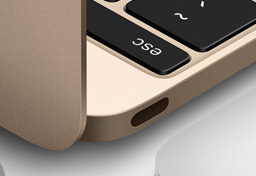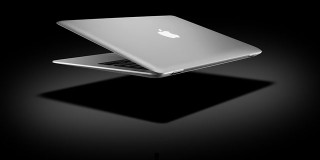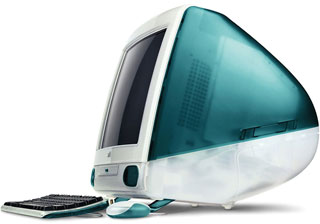There has been a lot of hand wringing over the new MacBook Pro with its Touch Bar – and complete lack of legacy ports. I understand. We’ve been here before.
![]()
The 12″ MacBook
 Remember when the 12″ MacBook was introduced in March 2015 with only a single USB-C port? Compared to the 13″ MacBook Air, it no longer had MagSafe for power, the ancient USB Type A port for peripherals, Thunderbolt, or an SDXC card slot.
Remember when the 12″ MacBook was introduced in March 2015 with only a single USB-C port? Compared to the 13″ MacBook Air, it no longer had MagSafe for power, the ancient USB Type A port for peripherals, Thunderbolt, or an SDXC card slot.
MagSafe is history, but a simple adapter can plug into the USB-C port so you can use a USB device with a Type A plug, or a Thunderbolt device, or an SDXC card reader. No, it’s not built into the 12″ MacBook, but if you’re plugging in an external device – whether a flash drive, printer, or display – carrying a little adapter shouldn’t be a great inconvenience.
Yes, it was rather short-sighted of Apple to include only a single USB-C port on the 12″ MacBook. That made it impossible to charge the MacBook’s battery and connect a device simultaneously without a special adapter. Two ports would have made much more sense.
Guess what? The low-end 13″ MacBook Pro has two USB-C ports, and the models with the Touch Bar have four of them.
The Original MacBook Air
 It was almost nine years ago – January 2008 – when Steve Jobs unveiled the slim, light MacBook Air. It was just over 3/4″ at its thickest point and weighed only 3.0 lb. It was no powerhouse, and you couldn’t expand its 2 GB of memory, and the iPod hard drive it used was excruciatingly slow, but it caught everyone’s imagination.
It was almost nine years ago – January 2008 – when Steve Jobs unveiled the slim, light MacBook Air. It was just over 3/4″ at its thickest point and weighed only 3.0 lb. It was no powerhouse, and you couldn’t expand its 2 GB of memory, and the iPod hard drive it used was excruciatingly slow, but it caught everyone’s imagination.
How many data ports did it have? Just two: One USB Type A port and one Micro-DVI port to support a monitor. It used MagSafe for power. And over time, Apple added more ports to the MacBook Air, as noted above.
BTW, if you use an old MacBook Air with a hard drive, upgrade to SSD for a huge boost in performance.
The Original iMac
 Going back to 1998, we had the iMac, which in many respects was a mold-breaker like the 12″ MacBook. That iMac had only one legacy port, ethernet. There was no SCSI port for your hard drive or scanner. There was no ADB port for your Apple Extended Keyboard II or TurboMouse trackball. There was no Mac serial port for your external modem – oh, wait, a 56k modem was built into the iMac.
Going back to 1998, we had the iMac, which in many respects was a mold-breaker like the 12″ MacBook. That iMac had only one legacy port, ethernet. There was no SCSI port for your hard drive or scanner. There was no ADB port for your Apple Extended Keyboard II or TurboMouse trackball. There was no Mac serial port for your external modem – oh, wait, a 56k modem was built into the iMac.
Also, there was no built-in floppy drive, which doomed it – according to PC pundits.
What happened? The iMac became the top selling computer model through the end of 1998, and anyone who wanted to sell a printer, scanner, multi-button mouse, or honest to goodness extended keyboard had to make it with USB. And for those wed to their old gear, there were USB adapters for ADB, SCSI, parallel printer ports, etc.
Although USB had been available since May 1996 and was built into many PC logic boards, by May 1998 – two years later and the month that Steve Jobs first showed off the iMac – the PC world stuck with its old parallel, serial, and PS/2 ports. The iMac forced the industry to actually use that USB port.
And just like we do today with USB-C, people griped about it.
Okay, the iMac did have two USB ports, but the keyboard/mouse used one, leaving only one available. Which helped create a market for USB hubs.
Full Circle

15″ MacBook Pro with Retina Display
If you’re upset about the MacBook Pro losing its legacy ports, your best bet is to buy the previous version with its two USB 3.0 ports, HDMI port, Thunderbolt 2 port, SDXC slot, and MagSafe for power. But if you want the new MacBook Pro, you’ll need to adapt to it.
Your best solution is probably a small hub that lets you charge your MacBook or MacBook Pro, gives you a couple USB Type A ports, includes an SDXC card slot, and maybe a few other legacy ports as well. While you’re at it, plan for the future and make sure it has a couple USB-C ports as well.
Don’t want to do that? You can still buy the 2015 model, which costs less and has the ports you know and love.
Yes, It Is a Pro Model
Look at the specs, not the ports. The Late 2016 MacBook Pro has plenty of power, plenty of speed, and enough memory for 90% of its users. If you truly need more than 16 GB in a MacBook, you’re going to have to wait for next year’s models, which will have a new chipset that supports more than 16 GB. For now, that’s as far as you can go with genuine Apple hardware.
You can always look into hackintoshing a PC laptop if that’s not good enough for you.
Of course, all the new PC laptops are sporting USB-C, so you may still have to buy those adapters….
Looking Forward
I’m hoping we’ll be seeing flash drives with both Type A and USB-C at competitive prices, which will eliminate one of the biggest gripes about the USB-C only models. The adapters are often bigger than the flash drives!
In a couple years, we’re going to look back and realize we made a mountain out of a mole hill, just like we did with the iMac in 1998. My guess is that everything will support USB-C by the end of 2018.
Keywords: #usbc #macbookpro
Short link: https://goo.gl/6HM6RR

